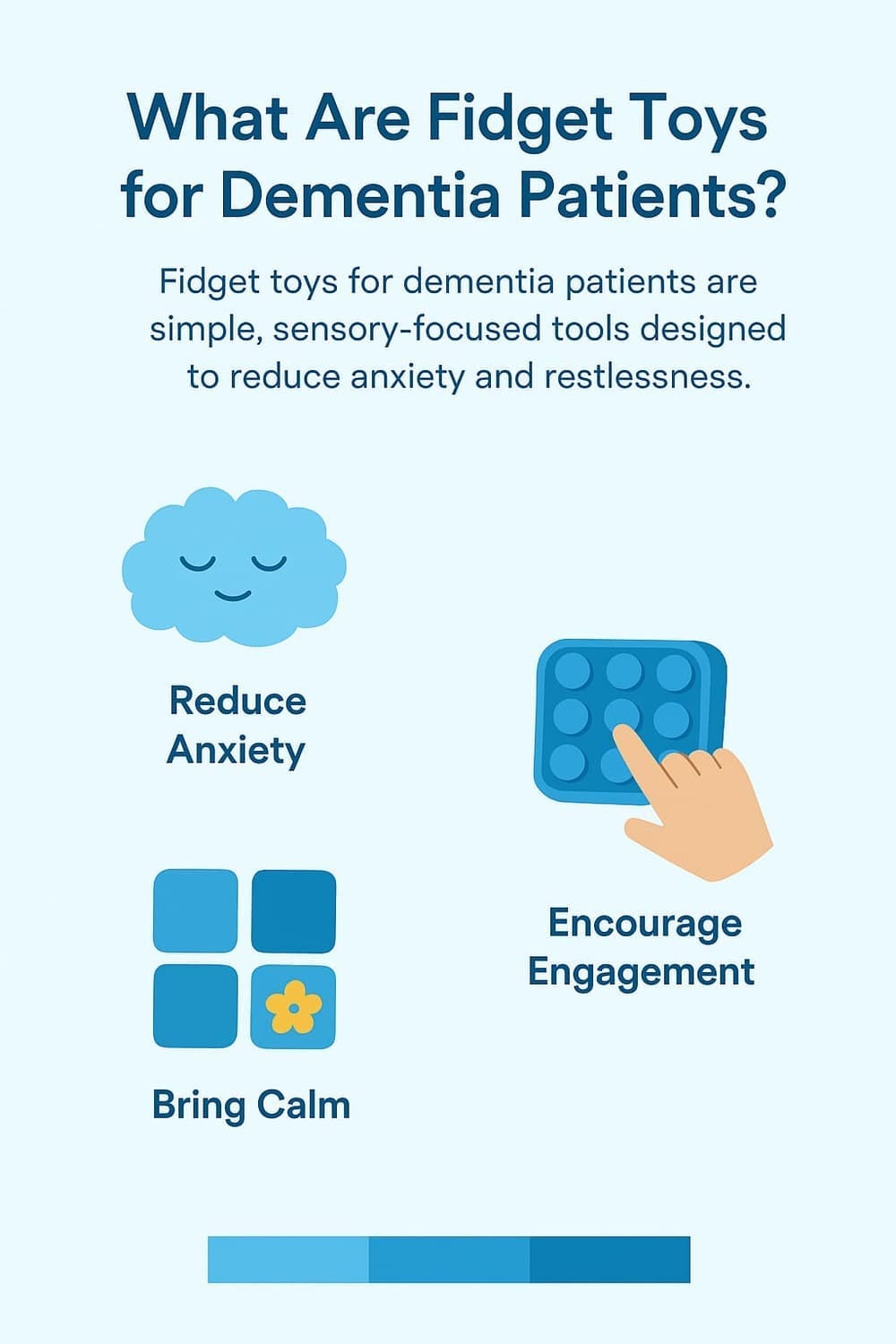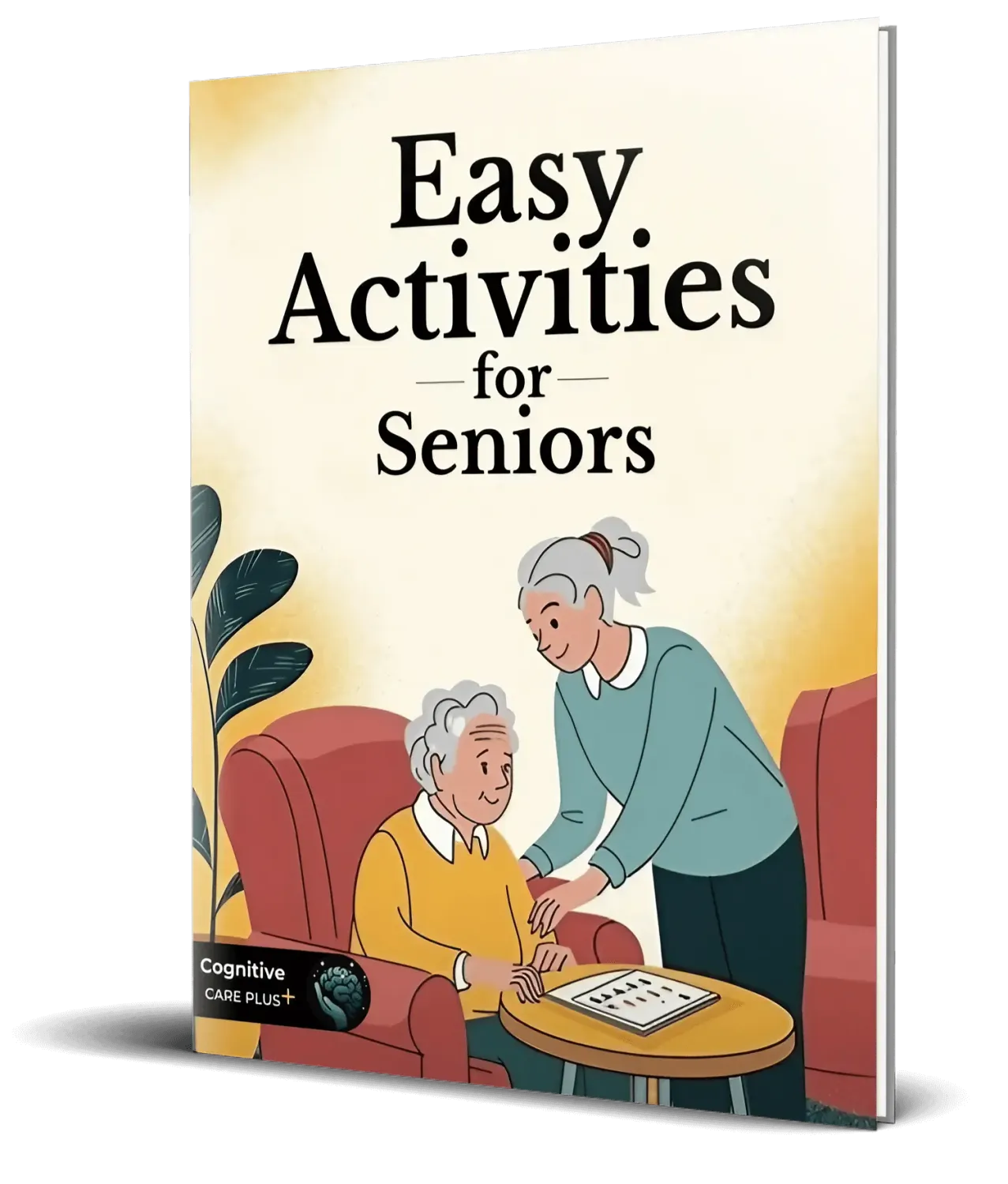Best Fidget Toys for Adults with Dementia to Reduce Anxiety
When Restless Hands Need Comfort: The Role of Fidget Toys in Dementia Care
If you care for someone living with dementia, you know how challenging anxiety and restlessness can be. These moments can disrupt daily routines, increase stress for both the person and the caregiver, and even lead to agitation.
Fidget toys for adults offer a simple yet powerful way to provide comfort, engage the senses, and create moments of calm. In this guide, you’ll discover the best options, how they work, and tips to choose the right one for your loved one.
🎧 Prefer to listen? Discover how fidget toys can ease anxiety and bring calm to adults with dementia in our quick podcast episode.
✨ Enjoyed the episode?
Subscribe to the Cognitive Care Plus Podcast for practical guides, expert insights, and compassionate support to help you care for your loved one with dementia.
What Are Fidget Toys for Dementia Patients?

Fidget toys are small, handheld or lap-based objects designed to keep the hands busy through repetitive, soothing movements. For people with dementia, these toys serve more than just a playful purpose: they offer sensory stimulation, emotional comfort, and a way to channel restless energy in a safe, constructive way.
From a neuropsychological perspective, engaging in tactile sensory activities supports attention, encourages fine motor skills, and may promote relaxation by stimulating areas of the brain related to sensory integration and emotional regulation.
Why Fidget Toys Help Reduce Anxiety in Dementia
Dementia can lead to changes in the brain that increase restlessness and reduce the ability to self-soothe. This can make anxiety more intense and frequent. Dementia fidget toys help by:
Providing a sensory anchor that redirects attention from distressing thoughts or stimuli.
Encouraging repetitive movements that are naturally calming, similar to knitting or squeezing a stress ball.
Offering a sense of familiarity and control through touch.
Supporting neuroplasticity — the brain’s ability to adapt — by engaging multiple senses at once.
💡 Caregiver tip: Introduce fidget toys during calm moments, not just during agitation, so they become a familiar and comforting tool.
Here’s a quick visual example of how a fidget toy can be used in daily life to provide comfort and engagement:
Best Fidget Toys for Adults with Dementia
1. Fidget Blanket / Fidget Blanket for Dementia
A fidget blanket is a soft lap-sized fabric with attached textures, zippers, ribbons, and buttons.
Benefits:
Stimulates touch, sight, and sometimes sound.
Provides safe, repetitive hand movements.
Reduces boredom and promotes relaxation.
2. Fidget Ball / Sensory Balls / Stress Balls for Adults / Therapy Balls / Hand Exercise Balls
These are soft, squeezable balls that fit comfortably in one hand.
Benefits:
Relieve muscle tension in the hands.
Promote fine motor coordination.
Offer rhythmic squeezing that lowers stress levels.
3. Fidget Apron
A wearable apron with sewn-on textures, pockets, and tactile elements.
Benefits:
Deep pressure stimulation promotes calm.
Reduces fidgeting by providing physical comfort.
Encourages longer seated focus during meals or activities.
4. Weighted Lap Blanket
A small blanket with evenly distributed weight, placed across the lap.
Benefits:
Deep pressure stimulation promotes calm.
Reduces fidgeting by providing physical comfort.
Encourages longer seated focus during meals or activities.
How to Choose the Right Fidget Toy
When selecting fidget toys for dementia patients, consider:
Stage of dementia — simpler toys for later stages. You can use our interactive dementia stages chart to better understand your loved one’s needs and choose a toy that matches their current abilities.
Sensory preferences — soft, textured, or weighted.
Ease of cleaning — washable materials for hygiene.
Safety — avoid small parts that could be swallowed.
For a curated selection of options tailored to different needs and stages, visit our guide to the best fidget toys for dementia patients to find the most suitable choice for your loved one.
Additional Activities for Seniors That Complement Fidget Toys
Pairing fidget toys with other activities for seniors can enhance their benefits:
Listening to calming music while using a fidget blanket.
Gentle chair exercises with therapy balls.
Storytelling or conversation while holding a sensory ball.
Conclusion & Caregiver Tip
Best fidget toys for adults with dementia are more than comfort objects — they are tools that promote emotional well-being, support sensory needs, and help caregivers create peaceful moments. Start with one or two options, observe how your loved one responds, and adjust as needed.
Research & Further Reading
For evidence-based insight into non-pharmacological approaches, see this PubMed review on sensory and memory stimulation in long-term dementia care.
FAQ
Are fidget toys good for dementia patients?
Yes, fidget toys can be very beneficial for people living with dementia. They help reduce restlessness and anxiety by providing a simple, soothing activity that engages the hands and senses. Using fidget toys supports focus and can improve mood, making daily moments more calm and manageable. These toys stimulate tactile and fine motor skills, which are important for maintaining brain function through sensory input.
For a real-world perspective on how sensory engagement—through items like fidget toys—can ease anxiety and support communication in dementia care settings, Heisinger Bluffs provides an insightful overview based on their daily care practices.
Are fidget toys safe for dementia patients?
Yes, as long as they are age-appropriate, free of choking hazards, and used under supervision when needed.
How to ease anxiety in dementia patients?
Easing anxiety in dementia patients involves creating a calm and predictable environment. Establishing daily routines, using sensory tools like fidget toys or comforting objects, and engaging in gentle activities such as music or light exercise can help reduce stress. It’s also important to speak calmly, offer reassurance, and minimize overwhelming stimuli. Tailoring approaches to the individual’s preferences and needs promotes comfort and emotional well-being.
What’s the difference between a fidget blanket and a weighted lap blanket?
A fidget blanket is designed for hand activity, while a weighted lap blanket uses gentle pressure to promote calm.
Can fidget toys help in late-stage dementia?
Yes, but simpler designs with strong sensory appeal work best in late stages.
👉 Looking for more engaging ideas for seniors? Explore all our categories to find activities, sensory tools, and brain-boosting resources for every stage of dementia care.
Share this article:
If this article helped you, share it with other caregivers who need encouragement.
💬 We’d love to hear from you!
Have you tried using fidget toys to help your loved one with dementia feel calmer and more engaged? What types have worked best for you, and what challenges have you faced? Share your experiences and tips in the comments below—your insights could help other caregivers discover new ways to bring comfort and connection.

Trending
Simple tools that make caregiving...
Turning simple play into a brain-boosting activity...
Here’s what to look for when choosing...

About me

Hi there 👋 My name is George Cassou, I'm a psychologist and the creator of this blog. Inspired by my journey caring for my mom with Alzheimer's, I share activities and tips to bring joy and connection.

Affiliate Disclosure:
This website contains affiliate links. If you click on these links and make a purchase, we may earn a small commission at no additional cost to you. These commissions help us keep this site running and allow us to continue creating helpful content to support caregivers and families.


